Comprehensive Guide to Designing a Pool and Landscaping in Australia – Guidelines
When designing a pool and its surrounding landscape in a climate as diverse as Australia’s, it’s essential to consider the unique environmental factors, aesthetic appeal, and functionality of the outdoor space. This guide will introduce the key concepts that will help transform your backyard into a luxurious pool oasis, whether you’re in a tropical or Mediterranean climate.
1. Understanding Your Climate: Tropical vs. Mediterranean
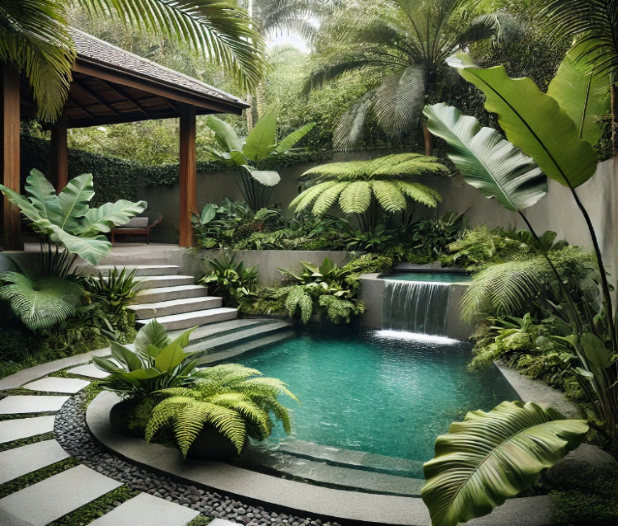 Tropical Climate Considerations:
Tropical Climate Considerations:
- Prioritise cooling effects and shade to escape heat and humidity.
- Choose materials that withstand intense sun, rain, and humidity.
- Incorporate lush, dense vegetation to create a natural, tropical feel.
- Ensure proper drainage to manage heavy seasonal rainfall.
- Consider features like waterfalls or misting systems for additional cooling.
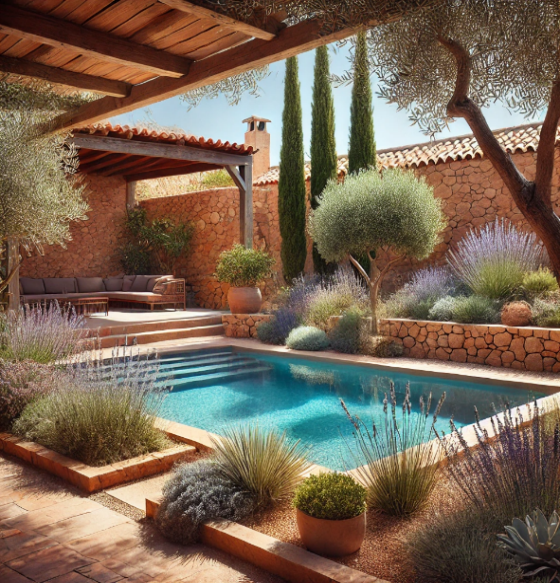 Mediterranean Climate Considerations:
Mediterranean Climate Considerations:
- Emphasise drought-resistant plants and materials that thrive in dry, hot summers and mild, wet winters.
- Use natural stone and earthy colours to complement the dry, sunlit surroundings.
- Opt for shaded areas, such as pergolas or gazebos, to provide relief from the sun.
- Focus on outdoor living spaces that transition smoothly between indoors and outdoors.
- Consider windbreaks for coastal areas or locations exposed to gusty conditions.
In a tropical climate, cooling effects are key. Shade from trees, pergolas, or built structures will create a comfortable oasis. Dense vegetation, like palms and ferns, lends a lush, natural look and can also help regulate the temperature by blocking the sun. On the other hand, a Mediterranean setting requires careful plant selection, with drought-tolerant plants like olive trees, rosemary, or lavender taking centre stage. The dry heat can be mitigated with natural stone surfaces that reflect the warmth but don’t overheat, allowing for comfortable outdoor living all year round.
2. Conceptual Pool Design
Pool Shape and Size:
- Consider the function of the pool: lap swimming, family fun, or aesthetic purposes.
- Fit the pool into the natural landscape, using organic shapes for tropical climates and more geometric designs for Mediterranean spaces.
- Ensure the pool complements the architecture of the house.
Location Relative to the House:
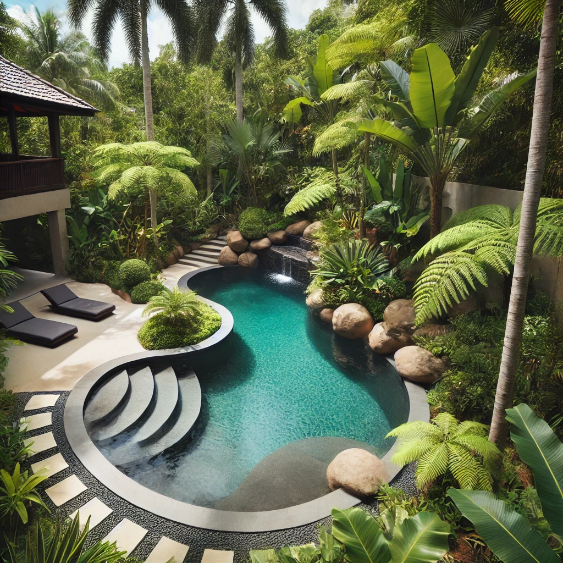 Position the pool close enough to the house for convenience but far enough for privacy.
Position the pool close enough to the house for convenience but far enough for privacy.- Consider sun exposure—position the pool to get ample sunlight during peak swimming hours.
- Align the pool with outdoor entertaining spaces for seamless integration
Poolside Amenities:
- Integrate features such as tanning ledges, swim-up bars, or submerged seating to enhance usability.
- Add depth variations to cater to different activities—shallow for lounging, deep for diving.
- Consider the placement of outdoor kitchens, showers, or lounges around the pool for convenience.
When conceptualising a pool, the shape and size should always complement the backyard and the house’s architectural style. A tropical environment lends itself to more organic, freeform designs that mimic natural bodies of water, while Mediterranean settings often benefit from geometric, linear designs for a cleaner, more minimalist look. Proper positioning relative to the house ensures ease of use and a balanced flow between indoor and outdoor living spaces.
3. Landscaping Around the Pool
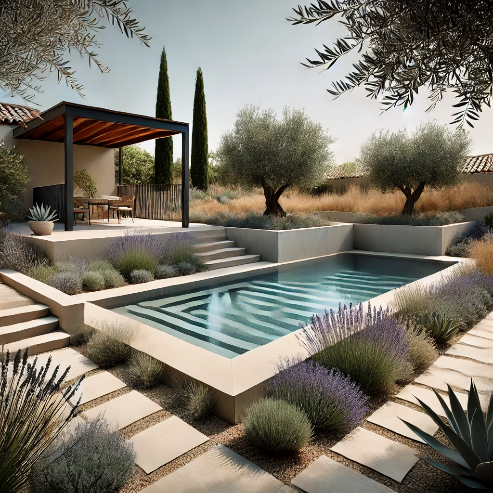 Vegetation Choices:
Vegetation Choices:
- Tropical: Use large-leaf plants, ferns, and palms for lush greenery that thrives in humidity.
- Mediterranean: Incorporate hardy, low-water plants such as succulents, olive trees, and native grasses.
- Avoid trees with invasive roots or excessive leaf drop near the pool area.
Hardscaping Materials:
- Tropical: Consider materials like travertine, natural stone, or timber for pathways and decking that complement a tropical setting.
- Mediterranean: Use terracotta tiles, limestone, or concrete pavers to echo the earthy tones of Mediterranean landscapes.
Visual Flow and Transition:
- Blend the pool into the surrounding environment by extending natural elements (rocks, plant beds) into the pool area.
- Create layers with different plant heights and textures for a more dynamic look.
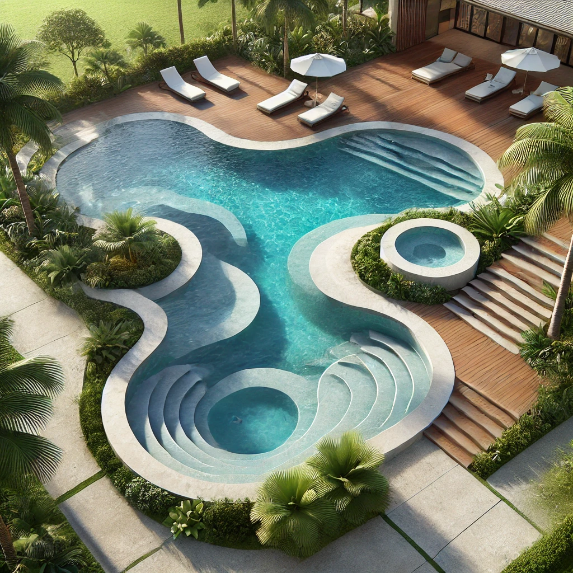 Consider how different areas of the yard (garden, pool, patio) transition into one another.
Consider how different areas of the yard (garden, pool, patio) transition into one another.
Landscaping is one of the most critical aspects of making your pool area feel integrated into the environment. In tropical climates, lush greenery and large-leaf plants can provide shade, privacy, and aesthetic appeal, while Mediterranean-style
landscaping thrives on sparser, sun-loving plants and simple, earthy hardscaping. In both cases, plants and materials should be chosen not just for their appearance but also for their ability to thrive in the given climate with minimal maintenance.
4. Boundaries and Privacy Considerations
Fencing and Privacy Screens:
- Tropical: Use bamboo or timber screens and hedges for a natural, secluded feel.
- Mediterranean: Opt for stone walls, wrought iron fences, or tall shrubs like cypress for a traditional Mediterranean look.
- Ensure any fencing meets local safety requirements, especially for pool safety compliance.
 Creating a Private Retreat:
Creating a Private Retreat:
- Use tall, dense planting or screens to shield the pool area from neighbours.
- Incorporate elements like pergolas or gazebos to create shaded, private nooks.
- Design the landscape with elevation changes or terracing to enhance privacy in sloped backyards.
Privacy is essential for creating a sense of sanctuary around your pool. Tall plants, hedges, or decorative screens can shield you from neighbours and block unwanted views. In tropical environments, fast-growing plants like bamboo or palms are excellent natural screens, while in Mediterranean settings, taller shrubs or stone walls create a more structured, timeless appeal.
5. Additional Features: Gazebos, Pergolas, and Water Features
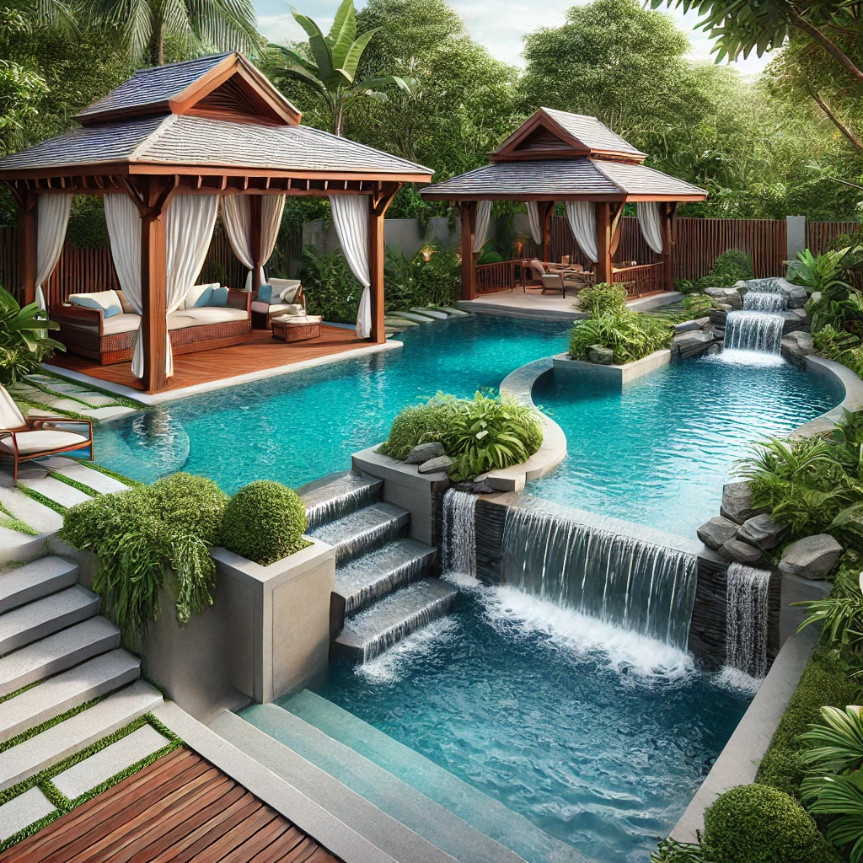 Gazebos and Pergolas:
Gazebos and Pergolas:
- Add shaded areas for relaxation and socialising, particularly important in both hot climates.
- Use materials like wood or stone that harmonise with the overall aesthetic.
- Place gazebos near the pool but separate enough to offer a sense of retreat.
Water Features:
- Tropical: Consider adding waterfalls or streams to create a natural, calming atmosphere.
- Mediterranean: Install fountains or reflective water surfaces to add elegance and serenity.
Lighting and Heating:
- Use warm-toned lighting for Mediterranean spaces and cool-toned or soft lighting for tropical environments to enhance the ambiance.
- Consider heating options like solar or gas heaters to extend the usability of the pool throughout the year.
Additional features such as gazebos or pergolas add functionality and beauty to the pool area, offering shaded spots for relaxing or dining. Water features, like waterfalls in a tropical garden or a reflective pool in a Mediterranean setting, can enhance the tranquil feel of the space. Lighting is also crucial for setting the mood, while heating options can make the pool accessible year-round, ensuring that the outdoor area is both practical and enjoyable in any season.
6. Working with a Designer: Bringing Your Vision to Life
Choosing the Right Designer:
- Look for a designer with experience in creating pools for your specific climate.
- Review past projects and ensure they align with your aesthetic preferences.
- Discuss budget constraints early to avoid surprises later in the process.
Collaborating on the Design:
- Share your ideas, inspirations, and practical needs with the designer.
- Ask for multiple design concepts and don’t be afraid to request adjustments.
- Make sure the design is functional, sustainable, and aligned with local regulations.
Budgeting and Timeline:
- Set realistic expectations for both costs and the timeline of the project.
- Factor in the cost of materials, labour, permits, and future maintenance.
- Ensure that any additional features, like water or fire elements, are accounted for in the budget.
Working with an experienced designer is key to transforming your ideas into a practical and beautiful reality. Clear communication, an understanding of the budget, and flexibility in making changes along the way will ensure that the final result meets your expectations.
This overview provides the foundation for creating a stunning backyard pool that blends seamlessly into the surrounding landscape. Next, we can delve deeper into specific design choices, construction methods, and additional features to create a step-by-step guide for the entire process.
Comprehensive Guide to Designing a Pool and Landscaping in Australia – Guidelines
When designing a pool and its surrounding landscape in a climate as diverse as Australia’s, it’s essential to consider the unique environmental factors, aesthetic appeal, and functionality of the outdoor space. This guide will introduce the key concepts that will help transform your backyard into a luxurious pool oasis, whether you’re in a tropical or Mediterranean climate.
1. Understanding Your Climate: Tropical vs. Mediterranean
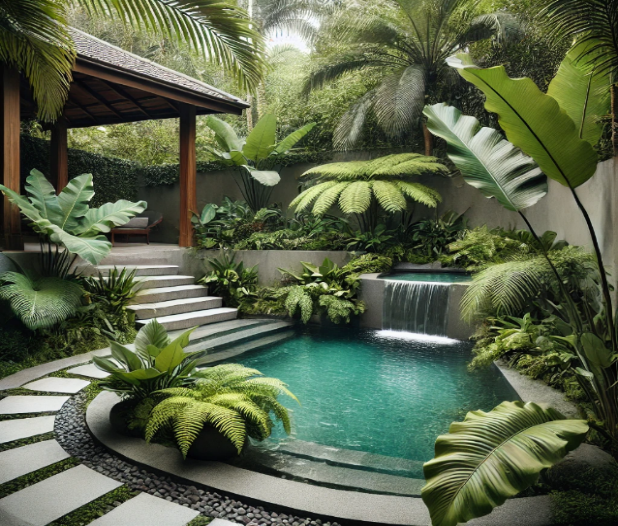 Tropical Climate Considerations:
Tropical Climate Considerations:
- Prioritise cooling effects and shade to escape heat and humidity.
- Choose materials that withstand intense sun, rain, and humidity.
- Incorporate lush, dense vegetation to create a natural, tropical feel.
- Ensure proper drainage to manage heavy seasonal rainfall.
- Consider features like waterfalls or misting systems for additional cooling.
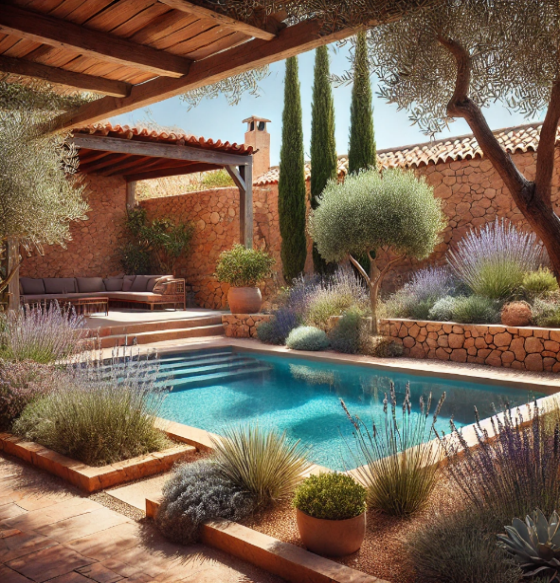 Mediterranean Climate Considerations:
Mediterranean Climate Considerations:
- Emphasise drought-resistant plants and materials that thrive in dry, hot summers and mild, wet winters.
- Use natural stone and earthy colours to complement the dry, sunlit surroundings.
- Opt for shaded areas, such as pergolas or gazebos, to provide relief from the sun.
- Focus on outdoor living spaces that transition smoothly between indoors and outdoors.
- Consider windbreaks for coastal areas or locations exposed to gusty conditions.
In a tropical climate, cooling effects are key. Shade from trees, pergolas, or built structures will create a comfortable oasis. Dense vegetation, like palms and ferns, lends a lush, natural look and can also help regulate the temperature by blocking the sun. On the other hand, a Mediterranean setting requires careful plant selection, with drought-tolerant plants like olive trees, rosemary, or lavender taking centre stage. The dry heat can be mitigated with natural stone surfaces that reflect the warmth but don’t overheat, allowing for comfortable outdoor living all year round.
2. Conceptual Pool Design
Pool Shape and Size:
- Consider the function of the pool: lap swimming, family fun, or aesthetic purposes.
- Fit the pool into the natural landscape, using organic shapes for tropical climates and more geometric designs for Mediterranean spaces.
- Ensure the pool complements the architecture of the house.
Location Relative to the House:
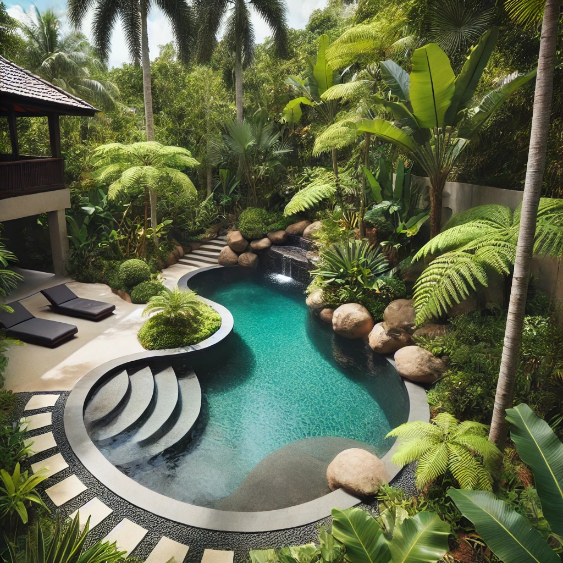 Position the pool close enough to the house for convenience but far enough for privacy.
Position the pool close enough to the house for convenience but far enough for privacy.- Consider sun exposure—position the pool to get ample sunlight during peak swimming hours.
- Align the pool with outdoor entertaining spaces for seamless integration
Poolside Amenities:
- Integrate features such as tanning ledges, swim-up bars, or submerged seating to enhance usability.
- Add depth variations to cater to different activities—shallow for lounging, deep for diving.
- Consider the placement of outdoor kitchens, showers, or lounges around the pool for convenience.
When conceptualising a pool, the shape and size should always complement the backyard and the house’s architectural style. A tropical environment lends itself to more organic, freeform designs that mimic natural bodies of water, while Mediterranean settings often benefit from geometric, linear designs for a cleaner, more minimalist look. Proper positioning relative to the house ensures ease of use and a balanced flow between indoor and outdoor living spaces.
3. Landscaping Around the Pool
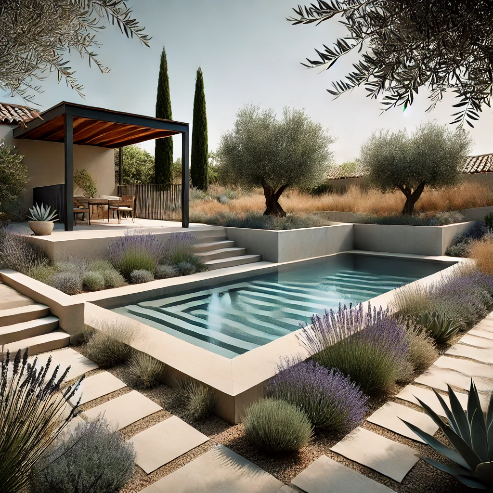 Vegetation Choices:
Vegetation Choices:
- Tropical: Use large-leaf plants, ferns, and palms for lush greenery that thrives in humidity.
- Mediterranean: Incorporate hardy, low-water plants such as succulents, olive trees, and native grasses.
- Avoid trees with invasive roots or excessive leaf drop near the pool area.
Hardscaping Materials:
- Tropical: Consider materials like travertine, natural stone, or timber for pathways and decking that complement a tropical setting.
- Mediterranean: Use terracotta tiles, limestone, or concrete pavers to echo the earthy tones of Mediterranean landscapes.
Visual Flow and Transition:
- Blend the pool into the surrounding environment by extending natural elements (rocks, plant beds) into the pool area.
- Create layers with different plant heights and textures for a more dynamic look.
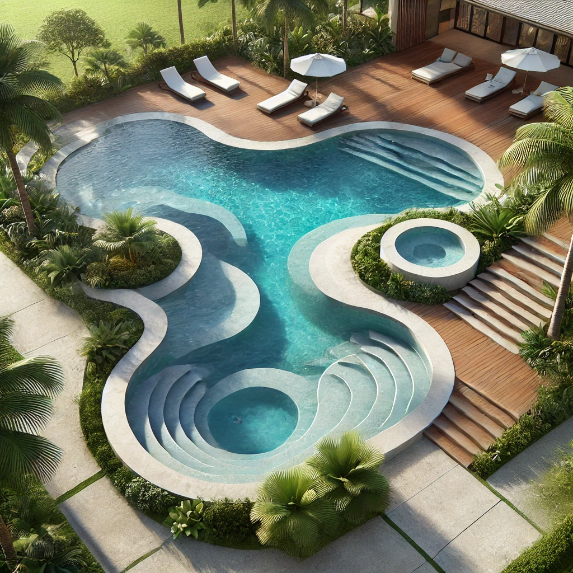 Consider how different areas of the yard (garden, pool, patio) transition into one another.
Consider how different areas of the yard (garden, pool, patio) transition into one another.
Landscaping is one of the most critical aspects of making your pool area feel integrated into the environment. In tropical climates, lush greenery and large-leaf plants can provide shade, privacy, and aesthetic appeal, while Mediterranean-style
landscaping thrives on sparser, sun-loving plants and simple, earthy hardscaping. In both cases, plants and materials should be chosen not just for their appearance but also for their ability to thrive in the given climate with minimal maintenance.
4. Boundaries and Privacy Considerations
Fencing and Privacy Screens:
- Tropical: Use bamboo or timber screens and hedges for a natural, secluded feel.
- Mediterranean: Opt for stone walls, wrought iron fences, or tall shrubs like cypress for a traditional Mediterranean look.
- Ensure any fencing meets local safety requirements, especially for pool safety compliance.
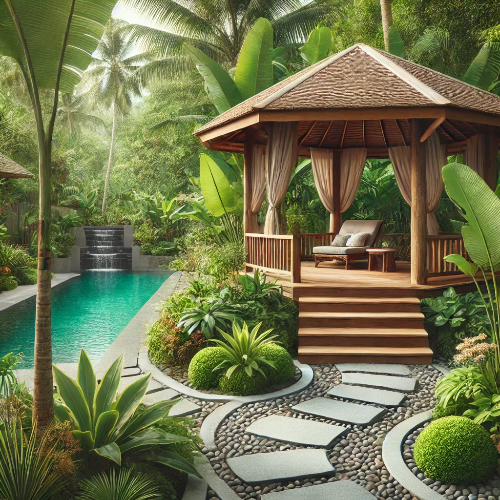 Creating a Private Retreat:
Creating a Private Retreat:
- Use tall, dense planting or screens to shield the pool area from neighbours.
- Incorporate elements like pergolas or gazebos to create shaded, private nooks.
- Design the landscape with elevation changes or terracing to enhance privacy in sloped backyards.
Privacy is essential for creating a sense of sanctuary around your pool. Tall plants, hedges, or decorative screens can shield you from neighbours and block unwanted views. In tropical environments, fast-growing plants like bamboo or palms are excellent natural screens, while in Mediterranean settings, taller shrubs or stone walls create a more structured, timeless appeal.
5. Additional Features: Gazebos, Pergolas, and Water Features
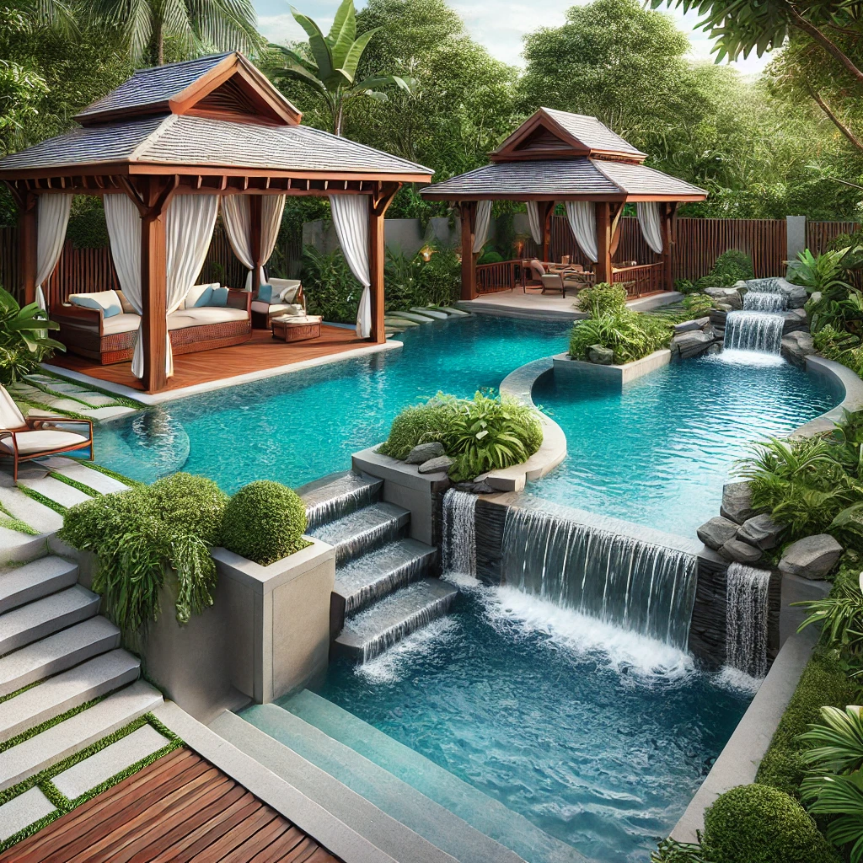 Gazebos and Pergolas:
Gazebos and Pergolas:
- Add shaded areas for relaxation and socialising, particularly important in both hot climates.
- Use materials like wood or stone that harmonise with the overall aesthetic.
- Place gazebos near the pool but separate enough to offer a sense of retreat.
Water Features:
- Tropical: Consider adding waterfalls or streams to create a natural, calming atmosphere.
- Mediterranean: Install fountains or reflective water surfaces to add elegance and serenity.
Lighting and Heating:
- Use warm-toned lighting for Mediterranean spaces and cool-toned or soft lighting for tropical environments to enhance the ambiance.
- Consider heating options like solar or gas heaters to extend the usability of the pool throughout the year.
Additional features such as gazebos or pergolas add functionality and beauty to the pool area, offering shaded spots for relaxing or dining. Water features, like waterfalls in a tropical garden or a reflective pool in a Mediterranean setting, can enhance the tranquil feel of the space. Lighting is also crucial for setting the mood, while heating options can make the pool accessible year-round, ensuring that the outdoor area is both practical and enjoyable in any season.
6. Working with a Designer: Bringing Your Vision to Life
Choosing the Right Designer:
- Look for a designer with experience in creating pools for your specific climate.
- Review past projects and ensure they align with your aesthetic preferences.
- Discuss budget constraints early to avoid surprises later in the process.
Collaborating on the Design:
- Share your ideas, inspirations, and practical needs with the designer.
- Ask for multiple design concepts and don’t be afraid to request adjustments.
- Make sure the design is functional, sustainable, and aligned with local regulations.
Budgeting and Timeline:
- Set realistic expectations for both costs and the timeline of the project.
- Factor in the cost of materials, labour, permits, and future maintenance.
- Ensure that any additional features, like water or fire elements, are accounted for in the budget.
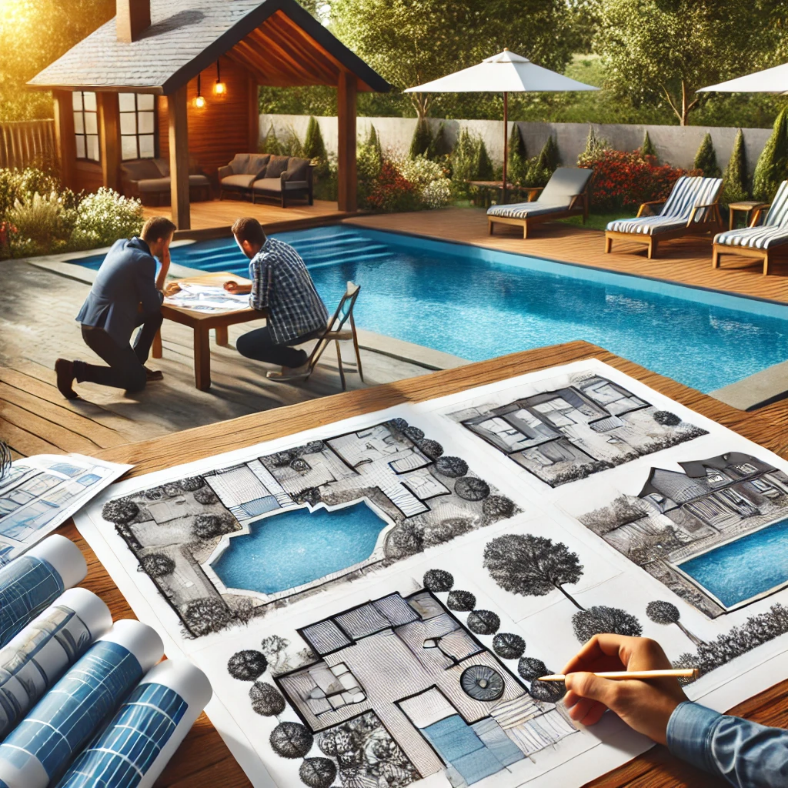
Working with an experienced designer is key to transforming your ideas into a practical and beautiful reality. Clear communication, an understanding of the budget, and flexibility in making changes along the way will ensure that the final result meets your expectations.
This overview provides the foundation for creating a stunning backyard pool that blends seamlessly into the surrounding landscape. Next, we can delve deeper into specific design choices, construction methods, and additional features to create a step-by-step guide for the entire process.
